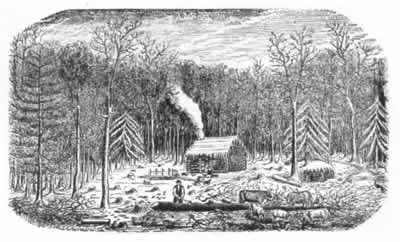 |
The |
|
Church Family Homestead
"Church Hollow" is marked on the Topozone USGS topographical map, as a narrow valley carved out of the eastern slope of the Rensselaer Plateau escarpment by an unnamed brook that tumbles down the hill to the Little Hoosic's flood plain, to empty into the river about a mile north of Petersburgh village. It appears that the Church Family leases from the Van Rensselaer Manor were a mile west of the flats, up a steep road that parallels the brook and rises approximately 500 ft. in that mile to the 1000 ft. elevation.
On the Rogerson "Map of Rensselaer County, 1854,"*(1) farms of "P. Church" and "S. Church" are shown adjacent to each other, "P. Church" being the homestead of Peter Church (1787-1878) and later his son Eliphalet (1815-1899) and Elipahlet's wife Patience Ann Stewart (1816-1919). The "P. Church" annotation is duplicated on the 1876 map of N.W. Petersburgh, his death not ocurring until two years later. Esther Church Bierwirth (1905-1996) remembered attending Patience Ann's 100th birthday celebration in 1916 at this location, where Eliphalet and Patience's daughter Eunice also lived.

Turner's Engraving
No. 1: The Pioneer in Winter
We have taken the liberty to quote from Philip Lord's lengthy and exacting research in "War over Walloomscoick: Land Use and Settlement on the Bennington Battlefield - 1777,"*(2). The following section in no doubt describes the first Church and Stewart homesteads to a tee:
One commonly held stereotype of late eighteenth century rural farms, lying outside the major river basins and beyond centers of population and cultural development, suggests a situation of a few scattered cabins, each surrounded by a minuscule clearing; a few acres of crop scratched in among the stumps. Orsamus Turner writing in the 1850s about this period, institutionalized the stages of pioneer development in a set of four annotated scenes representing the typical rural New York farm. Turner’s classic description of the primordial homestead seems to conjure up the popular image of such early frontier settlement:
The engraved view, No. 1, introduces the pioneer. It is winter. He has, the fall preceding, obtained his "article," or had his land "booked" to him, and built a rude log house; cold weather came upon him before his completion, and froze the ground, so that he could not mix straw mortar for his stick chimney, and that is dispensed with. He has taken possession of his new home.The oxen are browsing, with the cow and three sheep; the two pigs and three fowls that his young wife is feeding from her folded apron; these, with a bed, two chairs, a pot and kettle, and a few other indispensable articles for house keeping, few and scanty altogether, as may be supposed, for all were brought in upon that ox sled, through an underbrushed woods road; these constitute his worldly wealth. The opening in the woods is that only, which has been made to get logs for his house, and browse his cattle for the few days he has been the occupant of his new home.
He has a rousing fire; logs are piled up against his rude chimney back; his fire wood is convenient and plenty, as will be observed. There is a little hay piled on a hovel off to the right; the cattle and sheep well understand that to be a luxury only to be dealt out to them occasionally. The roof of his house is of peeled elm bark; his scanty window is of oiled paper; glass is a luxury that has not reached the settlement of which he forms a part. The floor of his house is of halves of split logs; the door is made of three hewed planks - no boards to be had - a saw mill has been talked of in the neighborhood, but it has not been put in operation.
Miles and miles off, through dense forest, is his nearest neighbor. Those trees are to be felled and cleared away, fences are to be made; here, in this rugged spot, he is to carve out his fortunes...
References:
(1) "Map of Rensselaer County, 1854," by J.E. Rogerson, New York State Library, Manuscripts and Special Collections
(2) "War over Walloomscoick: Land Use and Settlement on the Bennington Battlefield - 1777" by Philip Lord, New York State Museum Bulletin No. 473 ISBN 1-55557-186-7 "Thresholds of Settlement," p155
Church Home || Genealogy || Frank and Myrtle || History of Church Family in Petersburgh || Background of Settlement || The Journey
"The
Church Family of Petersburgh, NY featuring descendants of Frank and Myrtle
Church" website
at http://churchtree.tripod.com
©2002 by Daniel J. Bornt,
e-mail to: vanatalan@yahoo.com
